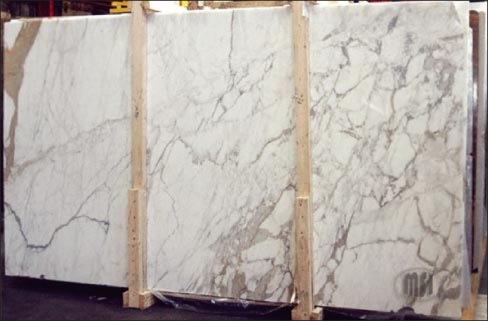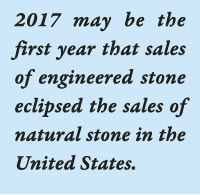The Eclipse of Natural Stone?
Mark McMunn
Photo courtesy MSI
In the pre-enlightenment era, a solar eclipse was something that portended an ill wind, be it a war, plague or some other burden that was sure to cause mankind grief. The great solar eclipse of 2017 has now come and gone, but has it heralded any changes to the stone industry? If we allow ourselves to be a little medieval for a minute, the answer has to be yes.
The dimensional stone industry has gone through many cycles of prosperity and decline over the course of the 20th century, and now the early 21st century. The difference now, though, is that those past cycles were all about the demand for natural stone, with engineered stone just making a hum in the background. In the past, the cycles of colors changed from decade to decade; for instance, consider that pinks and mauves were all the rage in the early to late 1980s, but now, you cannot sell anything with pink in it to save your soul. Recall also that pre-1992 the great majority of stone sales were for marble, travertine and other softer stones. Granite at that time was still pretty much the choice for wall veneer for the high-rise office buildings that were having a boom throughout most of the 1980s. Unexpectedly, designers began to realize that if granite looked great on an elevator lobby wall then it could also work on countertops as well. And with that realization, the granite kitchen countertop boom got under way, slowly at first, but increasing geometrically almost every year to the point that the demand for marble and granite flipped, with granite receiving the majority of demand and marble taking a greatly diminished but still significant second place to granite.
In the early ’90s, engineered stone was well on the radar, but there were at least two things holding it back. First, the material looked very much like terrazzo and while not being outright ugly, was plain and not very attractive, and no one wanted to risk stocking a material that the public was unfamiliar with, and it was light years away from the beauty of the exotic granites that began to pour into the marketplace. Secondly, the slabs were manufactured in a size that created a lot of waste when fabricating countertops for American-style homes. Additionally, ES was very expensive relative to natural stone, which almost made ES a non-starter in the American market, but it somehow managed to hold on.
The reason that this year’s eclipse, from a medieval perspective, is so significant is that 2017 may be the first year that sales of engineered stone eclipsed the sales of natural stone here in the United States. To the fabricator community this is not really significant because fabricators are just that, fabricators, not defined so much by what they fabricate but that they can fabricate, ES just being a new material to fabricate, just as granite was new to most shops in the early countertop days.
 |
|
Calacatta Marble is distinctive with its thick, bold veining. Rather than the plentiful soft veins of a marble like Carrara, Calacatta’s hallmark is fewer but more dramatic and unstructured veins. |
So what were the events that converged to create the ES boom? Being a third generation stone worker and a lifelong observer of the industry, the following explanation is strictly subjective and is not chiseled in stone, nor is it to be considered gospel in any way.
It appears that the greatest motivator for ES demand was the extreme prices commanded by the Calacatta marbles from Carrara, Italy. Though still commanding those high prices, ES Calacatta is daily making a significant dent in the demand for the natural material. You can be certain that the owners of the Calacatta quarries are feeling the pain. It is especially painful for the Calacatta quarries because they cannot sue for any kind of patent infringement or pirating of their product because there is no copyright protection for natural stone patterns that exist in nature, but be sure that some lawyer somewhere is working hard to try and remedy that – probably pointlessly.
The point is that the ES companies realized that if they could make synthetic Calacatta, then they could begin to capture some of the lucrative market for Calacatta marbles.
The ES companies had already begun to make new and more realistic-looking materials, and even the plain colors are now very attractive, so making exact, picture-like copies of Calacatta slabs was a simple step – and what a step it was.
 When the interior design community began to realize that ES Calacatta could deliver the same aesthetic and prestige as the natural material at a far lesser cost, they also began to finally look at ES as a whole, and see the benefits of specifying ES over natural stones.
When the interior design community began to realize that ES Calacatta could deliver the same aesthetic and prestige as the natural material at a far lesser cost, they also began to finally look at ES as a whole, and see the benefits of specifying ES over natural stones.
Aside from the lower cost of material, Calacatta ES took the risk out of the color consistency of the stone. A single-slab job presents no risk for color variation, but when you get into multi-slab projects, the risks can go up significantly, especially if the material is very expensive. Break one slab and your bookmatched job is shot, and all of a sudden, your once-profitable job will become break-even– if you’re lucky. ES slabs, which are difficult to break to begin with, can be easily replaced without the worry of the pattern changing. It is important to point out here that although the ES Calacatta slabs are much less expensive than the natural stone, for the most part ES is still significantly higher than most granites. However, that is also beginning to rapidly change.
As these words are being written, Consentino has introduced a set of colors called “group zero” that are priced about equal to level 1 and 2 granites. Consentino is making this move to secure their dominance in the marketplace against other ES producers, but an unintended consequence may be to further force out natural granite from the marketplace, much like granite forced out marble in the early 1990s.
Another factor that has played out to the benefit of ES producers was the introduction of the “Jumbo” slabs which finally fixed the waste factor problem that was keeping the material from being fully embraced by the fabricator community. So now the designer, fabricator and the consumer are all aligned to select and to use ES stones. Combine that with the fact that the possible colors, tones and textures for ES are infinite, and where does this leave natural marble and granite?
After all, with ES, a custom color and texture can now be custom made for a single project that can be patented and legally protected. This is especially important in commercial architecture so that a unique building can remain unique because it has a pattern and color that cannot be used in other buildings without permission, and certainly not without paying some kind of fee or royalty.
To understand why this is such a significant event, let’s step back and take a much broader view from an historical perspective. This is the first time in the history of the stone industry that a man-made product is displacing a natural material. The significant historical event is not so much that the material is man-made, but that people are deciding that the man-made material is more desirable than the natural material.
This brings up a very important question about what we value. How is it that we prize something as beautiful as natural Calacatta marble installations and pay princely sums for it, and then make a copy of it, install it for less, and still give it the mark of prestige equal to the natural material? We have made a derivative of a natural product, but now something new has come with it: derivative prestige.
Another solar eclipse will cross the United States in 2024. At that time, it will be interesting to see if this change from the natural to the derivative will have taken hold in other parts of the society. Already there is talk of robots as companions, which are really just derivative humans. As for the natural stone industry, the embracing of ES is just beginning and is building up steam. In seven years time we may very well be making custom countertops with massive 3D printers. Let us just wait and see.